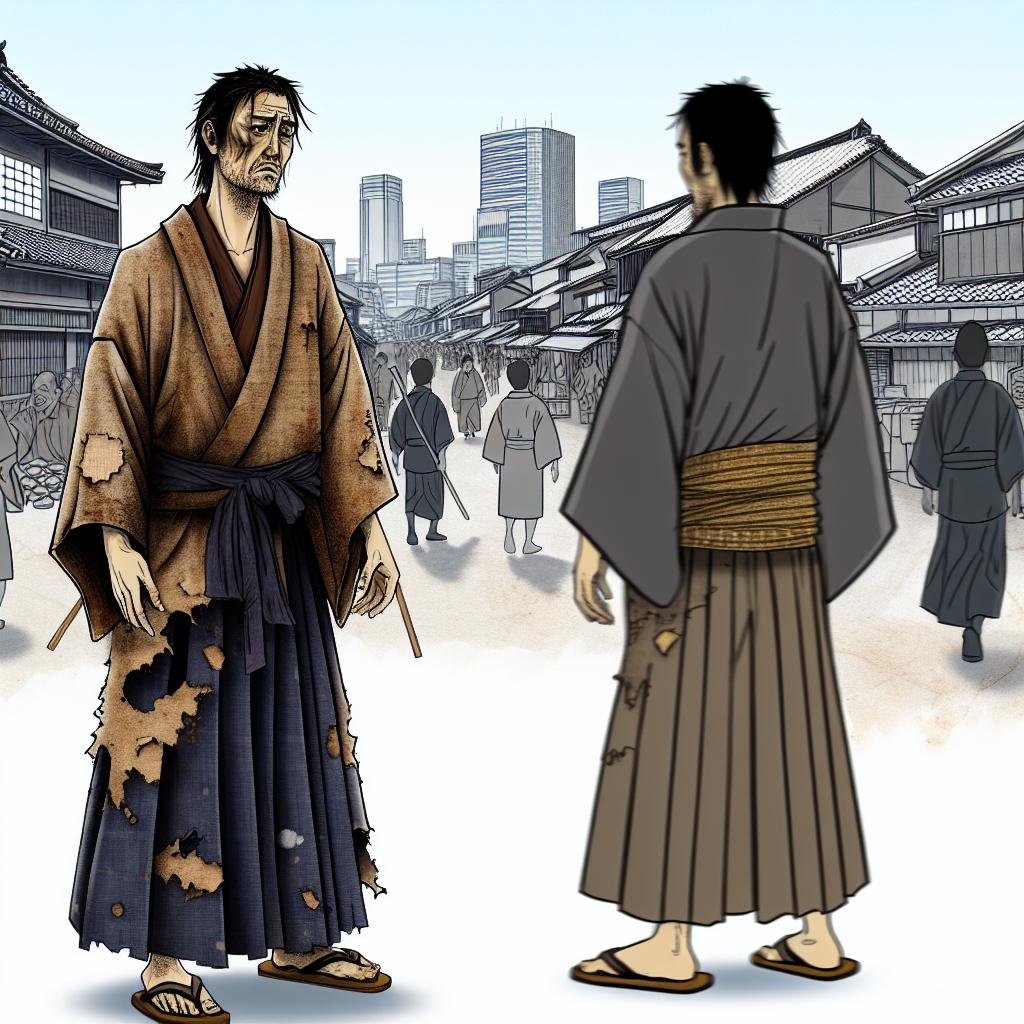The Economic Struggles of Ronins in the Tokugawa Era
During the Tokugawa era in Japan, the class of ronin faced significant economic challenges. These masterless samurai had lost their positions, often due to the death or dispossession of their lord, and were consequently left without both employment and social status. This predicament made economic survival a constant struggle.
The Ronin Background
The term ronin refers to a “wave man,” a label that symbolizes someone as unpredictable and unreliable as a wave. During the Tokugawa period, a rigid social hierarchy defined the roles of all individuals, with samurai positioned at the top of this societal pyramid. They served their lords, known as daimyo, providing military service and protection in return for financial and social security. When a samurai became a ronin, he lost the crucial protection and financial support of his daimyo, leading to a precarious lifestyle fraught with uncertainty.
Economic Dislocation
The economic struggles of ronin were primarily due to their sudden dislocation from the traditional feudal support system. Without a lord to serve, these samurai faced not only unemployment but also the wider specter of poverty. While being masterless carried a certain romantic aura, the practical realities were grim. Samurai skills in military arts and strategy were not broadly applicable during the relatively peaceful Tokugawa era. The absence of warfare or military conflict led to a diminished demand for their services, causing many ronin to struggle to find suitable work.
The struggles were compounded by the lack of a social safety net. As samurai, they were not trained in agrarian or mercantile skills, and thus found it challenging to transition into other occupational roles. Many had devoted their entire lives to mastering the arts of war, leaving them ill-prepared for a society focused on commerce and production.
Alternative Occupations
In an attempt to adapt to their new circumstances, some ronin sought alternative occupations. Some attempted to leverage their education and mastery in martial arts to become teachers, instructing the younger generation in swordsmanship and strategy. Others found roles as bodyguards for merchants or acted as mercenaries, offering their expertise for a fee. However, such positions were limited in number and not easily obtained. The societal hierarchy placed the merchant or artisan classes at a lower status, creating a cultural barrier for ronin transitioning into these fields. Even when they did find work, it was often inconsistent and poorly remunerated.
Some ronin demonstrated entrepreneurial spirit by entering into commercial enterprises, often starting small shops or engaging in trade. This, however, required seed money and networks, both of which ronin typically lacked. Moreover, the strict guild system of the time restricted entry into various trades, creating yet another obstacle.
The Challenges of Adaptation
These economic hardships and the difficulty in adapting led many ronin to live itinerant lifestyles, moving from place to place in an ongoing search for opportunity. The social stigma attached to their status compelled them to maintain a low profile and remain on the move. This instability further compounded their difficulties in establishing stable livelihoods.
A minority of ronin turned to farming, although their lack of experience and societal bias against such occupations often limited their success. Others, facing stark choices, resorted to crime, finding it an expedient, albeit risky, avenue for survival. This lawlessness further tarnished their reputations, causing them to be viewed with suspicion and disdain, thereby perpetuating the cycle of poverty and instability.
The rigid class structure of the Tokugawa era left scant room for upward mobility. The avenues available for improving one’s social and economic situation were largely inaccessible to ronin, who found themselves trapped at the fringes of society.
Societal Perceptions and Government Policies
Societal perceptions of ronin varied widely. Some people viewed them as fallen warriors who were honorably seeking new ways to support themselves, while others saw them as treacherous wanderers with questionable loyalties. This bifurcated view was deeply ingrained in the public consciousness, affecting how ronin were treated socially and economically.
From a governance perspective, the eyes of the Tokugawa shogunate remained focused on maintaining its meticulously constructed social order. The plight of ronin was largely ignored, with no tailored policies or support systems to aid their integration back into society. The government’s primary concern was stability and order, often leaving those who fell outside the primary social structures to fend for themselves. This lack of governmental intervention left many ronin without support networks or welfare systems that could have mitigated their economic adversities.
Conclusion
The economic struggles of the ronin during the Tokugawa era underscore the difficulties faced by individuals who found themselves outside the era’s rigid social and economic structures. Despite their noble origins, many ronin lived in poverty, their status stripped from them, and their skills rendered largely obsolete. These circumstances forced them to confront significant societal and economic barriers as they navigated this challenging landscape. The struggles of the ronin highlight not only the personal challenges of adaptation but also reflect the broader societal issues concerning mobility and class in pre-modern Japan. Through this lens, one can appreciate both the historical impact and the enduring legacy of these masterless warriors in Japanese culture and history.

